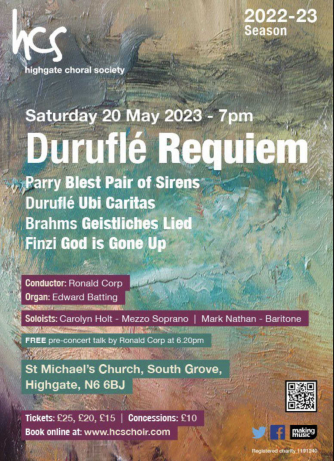Details
St Michael's Church
South Grove
Highgate
London
N6 6BJ
England
Programme
Maurice Duruflé – Requiem, Op.9
Gerald Finzi – God is gone up, Op.27 no.2
Johannes Brahms – Geistliches Lied, Op.30
Charles Hubert Hastings Parry – Blest Pair of Sirens
Maurice Duruflé – Ubi Caritas, Op.10 no.1
Performers
Carolyn Holt – mezzo-soprano
Mark Nathan – baritone
Edward Batting – Accompanist
Ronald Corp – Conductor
Highgate Choral Society
Programme Note
HCS’s Spring concert presents a cornucopia of nineteenth and twentieth century sacred choral music from France, England and Germany - including a celebrated setting of the Catholic requiem mass.
Maurice Duruflé’s Requiem, opus 9, dedicated to the memory of his father, is an adaptation of the Gregorian Missa pro defunctis (Mass for the Dead) that draws its musical themes from the original Gregorian chant. The French composer’s best known work, the Requiem was completed in September 1947 and first broadcast on French Radio in November 1947. Scored for mezzo soprano and baritone soloists and mixed choir with organ or orchestra, the work is in nine movements and is distinguished by its calm, meditative atmosphere and subtle, richly expressive harmonies. Also drawing on Gregorian chant is Ubi Caritas et Amor (Where Charity and Love Are), a sacred motet composed by Duruflé in 1960.
The English composer Sir Hubert Parry’s famous anthem Blest Pair of Sirens was written in 1887 and enthusiastically received at its première that year in celebration of Queen Victoria’s Jubilee. The piece is a setting of the seventeenth century ode At a Solemn Musick by John Milton, describing the rapture experienced on listening to sacred music. Scored for eight-part choir and organ or orchestra, it was Parry’s first major choral work. From the twentieth century, God is Gone Up is an outstanding anthem by the English composer Gerald Finzi written for the 1951 St Cecilia’s Day service at St Sepulchre’s Church in Holborn and scored for mixed choir and organ.
The programme also includes the beautiful Geistliches Lied (Sacred Song) by the German composer Johannes Brahms, written in I856 as part of his early studies in counterpoint and scored for mixed choir and organ.

 Your events at Classical Events
Your events at Classical Events

